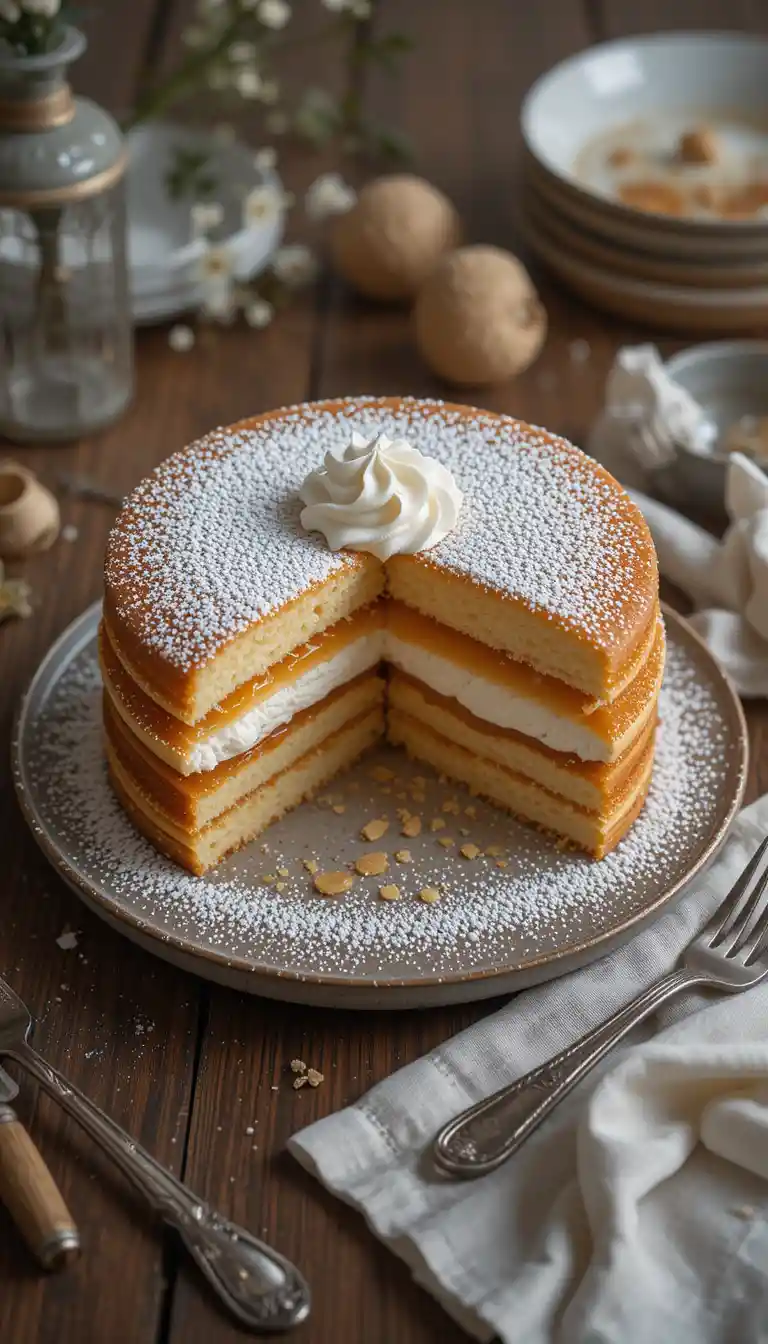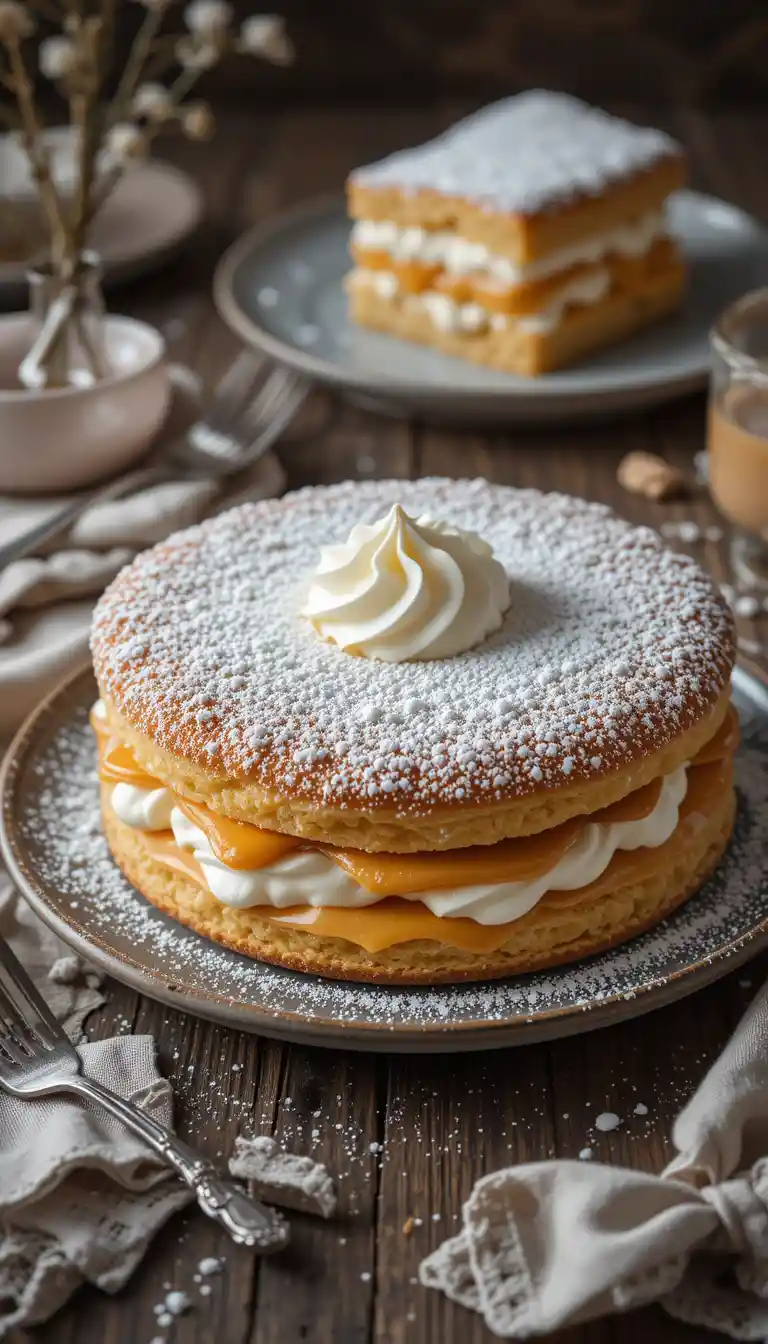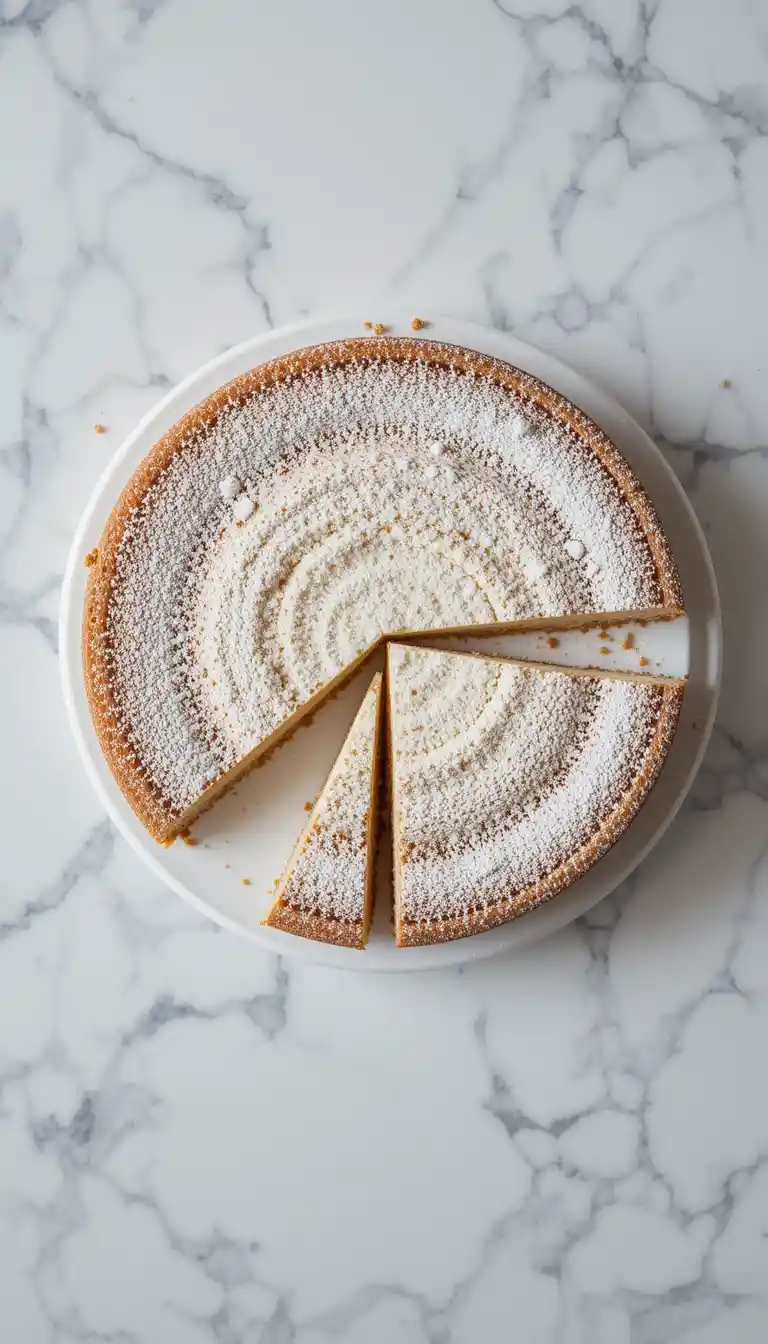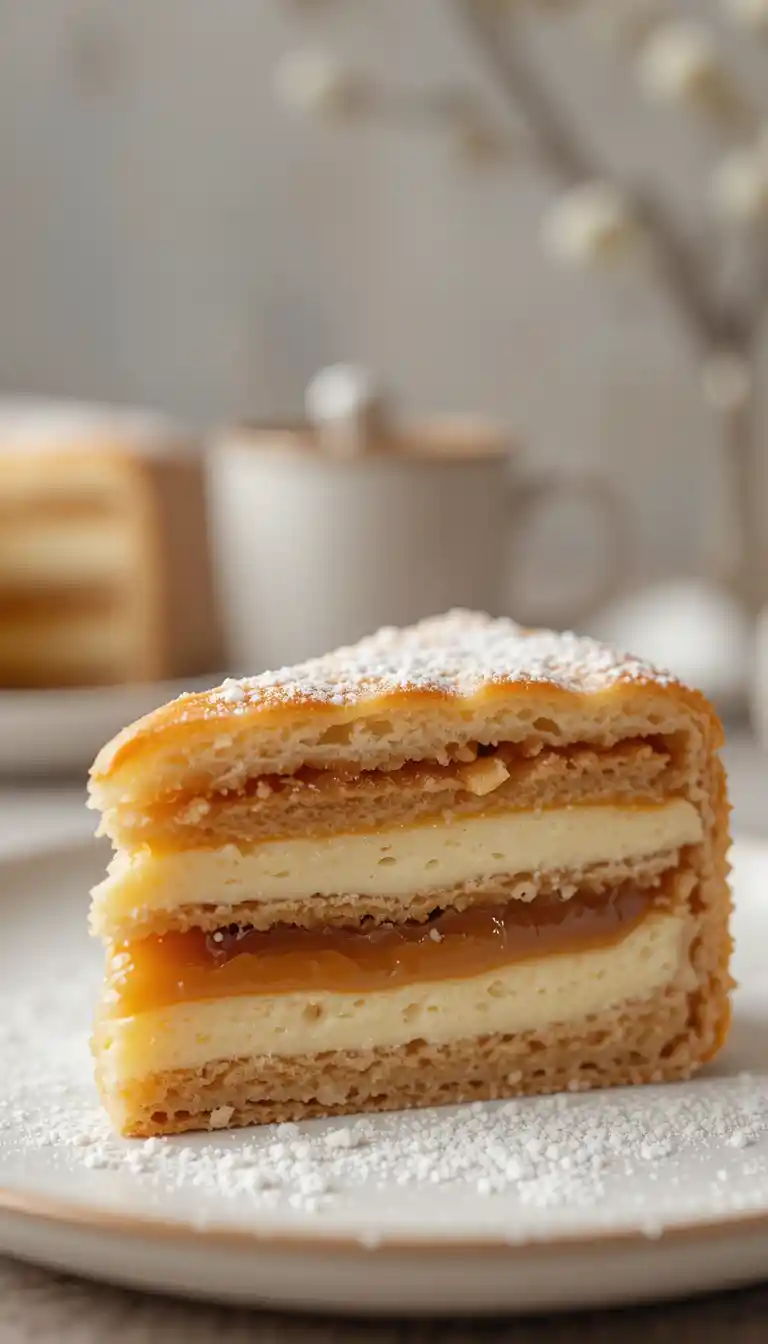Milhojas Cake Recipe
Have you ever taken a bite of a perfectly made milhojas cake and felt the delicate layers shatter between your teeth? There’s something truly magical about that moment when the crisp pastry and smooth filling create a perfect harmony of textures and flavors in your mouth. After spending countless hours in my kitchen perfecting this classic dessert, I can assure you that creating the perfect milhojas thousand-layer cake at home is absolutely within your reach.
Whether you’re preparing for a family gathering, celebrating a special occasion, or simply want to challenge your baking skills, this guide will walk you through every step of creating this impressive yet surprisingly approachable masterpiece. The beauty of milhojas cake lies in its simple ingredients transformed through technique into something extraordinary.
Table of Contents
What is Milhojas Cake? Understanding the Basics
Milhojas cake (meaning “thousand leaves” or “thousand sheets”) is a classic pastry that has traveled across continents, evolving along the way. This elegant dessert features multiple layers of delicate puff pastry filled with various creams and sometimes fruit. Known as milhojas thousand sheets cake in English-speaking countries, it’s particularly cherished throughout Latin America.
The dessert traces its roots back to the French “mille-feuille” but has been lovingly adopted and adapted across Spanish-speaking countries. In Chile, milhojas cake has achieved near-iconic status as a celebration dessert. The Chilean version typically features manjar (their version of dulce de leche) between each delicate layer, creating a sweet, caramel-like flavor that perfectly complements the crisp pastry.
What makes milhojas truly special is how it transforms humble ingredients into something spectacular through technique and patience. Unlike many modern desserts that rely on unusual or expensive ingredients, milhojas cake showcases the beauty of baking fundamentals done right.
“The true art of milhojas isn’t just in the recipe—it’s in understanding how the butter, flour, and time work together to create those perfect, airy layers that shatter at first bite.”

Essential Ingredients and Equipment
Before diving into the baking process, gathering the right ingredients and tools will set you up for success. The beauty of milhojas cake lies in its simplicity—you don’t need exotic ingredients, just quality basics handled with care.
What You’ll Need for Perfect Milhojas
Ingredients Table:
| Ingredient | Quantity | Notes |
|---|---|---|
| All-purpose flour | 2 cups (250g) | Chilled in the freezer for 15 minutes |
| Unsalted butter | 1 cup (2 sticks/226g) | European-style preferred, very cold, cut into cubes |
| Cold water | ½ cup (120ml) | Ice cold |
| Salt | 1 teaspoon | Fine sea salt works best |
| Heavy cream | 2 cups (480ml) | For filling, at least 36% fat content |
| Confectioners’ sugar | 1 cup (120g) | Plus more for dusting |
| Vanilla extract | 2 teaspoons | High-quality pure extract |
| Dulce de leche | 1 cup (300g) | Store-bought or homemade |
| Lemon juice | 1 teaspoon | Helps stabilize the cream |
Equipment You’ll Need:
- Rolling pin (preferably marble for keeping the dough cold)
- Baking sheets
- Parchment paper
- Pastry brush
- Kitchen ruler (for even layers)
- Fork (for docking the dough)
- Offset spatula
- Serrated knife
- Stand mixer or hand mixer
Your ingredients should be very cold, and you’ll want to work in a cool kitchen if possible. If your kitchen runs warm, you’ll need to refrigerate the dough more frequently between steps.
Don’t worry if you can’t find European-style butter—regular unsalted butter works fine, though the higher fat content in European varieties does produce slightly flakier results. And if specialized equipment seems daunting, remember that generations of home bakers created magnificent milhojas cakes with just basic kitchen tools.
Step-by-Step Baking Process: Creating the Perfect Easy Milhojas Cake
Now that you’ve gathered your ingredients and equipment, let’s break down the process into manageable steps. While making milhojas requires time, each step is straightforward.

Preparing the Puff Pastry
The foundation of any great milhojas thousand-layer cake, is properly made puff pastry. While store-bought can work in a pinch, homemade pastry delivers superior flavor and that distinctive shattering texture.
- Start with a cold workspace. If possible, chill your countertop with ice packs wrapped in towels for a few minutes before beginning.
- Add ice water gradually, stirring with a knife until the dough just comes together. You may not need all the water—stop adding when the dough forms a rough ball.
- Prepare your butter block by placing the remaining butter between two sheets of parchment paper. Use your rolling pin to pound it into a flat rectangle about 6×9 inches.
- Complete your first turn by rolling this package into a rectangle roughly 10×18 inches, then folding it in thirds like a letter. Wrap and chill for 30 minutes.
Remember, patience is key here. Rushing through the folding process or skipping chilling times will result in butter melting into the dough rather than creating those desirable separate layers.
Baking the Pastry Sheets
Once your puff pastry is ready, it’s time to transform it into the crisp layers that give milhojas their name.
- Roll your finished puff pastry to about ⅛ inch thick. For a traditional rectangular milhojas, aim for a large rectangle that you’ll cut into equal-sized pieces after baking.
- Dock the dough thoroughly with a fork, making small holes all over the surface. This prevents uneven puffing during baking.
- Bake for 15 minutes, Continue baking for another 5-10 minutes until the pastry is golden brown and fully cooked.
- Cool completely on wire racks before handling. The pastry will crisp up further as it cools.
The key here is achieving even baking without burning. Watch carefully during the final minutes—the difference between perfectly golden and overly browned happens quickly!
Fillings and Assembly
Now comes the fun part—creating the creamy fillings that will nestle between your perfectly baked pastry layers.
Traditional Dulce de Leche Filling (Chilean Style)
For an authentic milhojas cake, Chile style:
- Use store-bought dulce de leche or make your own by slowly simmering a can of sweetened condensed milk (in a water bath) for about 3 hours.
- Once cooled, beat the dulce de leche with a spoon to soften it for easy spreading.
Classic Whipped Cream Filling
For a lighter alternative:
- Add ⅓ cup confectioners’ sugar and 1 teaspoon vanilla extract.
- Continue whipping until firm peaks form, being careful not to overwhip.
Assembly Instructions:
- Place your first sheet of baked pastry on a serving platter or board.
- Gently place the next pastry sheet on top, pressing down very lightly.
- For the traditional milhojas thousand-layer cake, aim for at least 5-7 layers of pastry, though some ambitious bakers create versions with many more.
- Once assembled, refrigerate for at least 2 hours (preferably 4) to allow the fillings to set and the pastry to slightly soften from the moisture of the cream.
The key to perfect assembly is even layers of both pastry and filling. Use your offset spatula to create smooth, level filling layers of equal thickness.
Finishing Touches
The final presentation transforms your milhojas from merely delicious to truly spectacular:
- For a more elaborate finish, create a simple glaze by mixing 1 cup confectioners’ sugar with 2-3 tablespoons of milk or water and a drop of vanilla.
- For chocolate lovers, drizzle melted dark chocolate in a decorative pattern across the top.
Serving and Storage Tips
Timing is everything when it comes to serving the perfect milhojas cake. Here’s how to ensure your creation is enjoyed at its peak:

When to Assemble for Optimal Texture
- Assemble your milhojas 4-6 hours before serving for the ideal balance of crisp layers and softened filling.
- If assembled too far in advance, the pastry may become soggy; if served immediately after assembly, it may be too crisp and difficult to cut cleanly.
- Room temperature serving brings out the flavors best—remove from refrigeration about 30 minutes before enjoying.
Storage Solutions
- For longer storage, freeze unassembled components separately—baked pastry sheets will keep in an airtight container for up to a month.
- Already assembled milhojas don’t freeze well, as the texture significantly deteriorates upon thawing.
Troubleshooting Common Issues
Even experienced bakers encounter challenges when making milhojas cake. Here are solutions to common problems:
Why Your Pastry Might Not Be Flaky
- Temperature problems: If your butter melts into the dough rather than creating separate layers, your ingredients weren’t cold enough. Next time, chill everything more thoroughly between turns.
- Overworking the dough: Handling the dough too much develops gluten, resulting in tough rather than flaky pastry. Use light, quick movements.
- Skipping the docking step: Those little fork holes are crucial for even baking—without them, your pastry may puff unevenly or bubble dramatically.
Filling Failures and How to Fix Them
- Runny cream: If your whipped cream isn’t holding its shape, try adding 1 teaspoon of unflavored gelatin bloomed in 1 tablespoon of cold water, then melted and cooled slightly before being beaten into the cream.
- Soggy bottom layers: Apply a thin layer of melted chocolate to the bottom pastry sheet and allow it to set before adding fillings—this creates a moisture barrier.
- Filling oozing out: Your filling may be too soft, or you may have applied too much pressure when assembling. Use less filling or chill it longer before assembly.
Exploring Regional Flavors in the Milhojas Cake Recipe
One of the joys of milhojas cake is how it’s been adapted across different cultures. Try these variations to explore the dessert’s versatility:
- Chilean Milhojas: The classic version with manjar (dulce de leche), often topped with a thin layer of meringue that’s lightly torched.
- Argentinian Milhojas: Similar to the Chilean version but sometimes incorporating layers of quince paste (membrillo) for a sweet-tart contrast.
- Spanish Milhojas: Often filled with pastry cream infused with cinnamon or citrus zest, sometimes incorporating thin slices of poached fruit between layers.
- Modern Interpretations: Contemporary pastry chefs are creating versions with coffee cream, chocolate ganache, or even savory versions with herb-infused mascarpone and roasted vegetables.

Time to Create Your Own Milhojas Masterpiece!
Now that you’ve learned the secrets of creating a perfect milhojas thousand-layer cake, it’s time to roll up your sleeves and try it yourself. Remember that practice makes perfect—even if your first attempt isn’t bakery-window worthy, it will likely still taste delicious!
The joy of making milhojas cake comes not just from the impressive final result but from mastering the techniques that connect you to centuries of baking tradition. Each time you fold that dough or smooth that filling, you’re participating in a culinary art form that has brought delight to countless people across continents and generations.
Git more recipes you might like
- mini cakes
- Chocolate Chip Cookies
- Sola Bread
- Ghirardelli Chocolate Experience
- Blueberry Coffee
- Best Van Leeuwen Ice Cream
Frequently Asked Questions About Milhojas Cake
Can I make milhojas cake ahead of time?
You can prepare the pastry sheets 2-3 days in advance and store them in an airtight container. For the best texture, assemble with filling no more than 6-8 hours before serving.
What’s the difference between milhojas cake and Napoleon cake?
While both are layered pastries, traditional milhojas cake in Latin America often uses dulce de leche as filling, while Napoleon typically features vanilla custard. The milhojas thousand-thousand-sheet cake also tends to have more layers than a typical Napoleon.
Is there a shortcut to make easy milhojas cake?
For a quicker version, you can use high-quality store-bought puff pastry. While homemade pastry offers superior flavor and texture, this substitution can make easy milhojas cake accessible for beginners or when time is limited.
How do I prevent my milhojas cake from becoming soggy?
Allow your pastry sheets to cool completely before assembly, and consider applying a thin layer of melted chocolate between the pastry and cream layers to create a moisture barrier.
What is the authentic milhojas cake, Chile style?
The Chilean version (milhojas cake Chile) typically features manjar (Chilean dulce de leche) between layers and often has a top sprinkled with powdered sugar rather than fondant icing used in European versions.
Can I freeze milhojas cake?
It’s best to freeze components separately rather than the assembled cake. Baked pastry sheets freeze well for up to a month when properly wrapped.
Why is my puff pastry not rising properly?
If your puff pastry isn’t rising into distinct layers, the most common issues are butter that melted into the dough (rather than staying as distinct layers), overworking the dough, or not allowing enough resting time between folds.

Share your milhojas creations with friends and family, experiment with different fillings that speak to your taste, and most importantly, enjoy the process. There’s something deeply satisfying about transforming simple ingredients into something so spectacularly delicious through nothing but technique and care.
Are you ready to create your show-stopping milhojas cake? Gather your ingredients, clear your schedule for a leisurely baking day, and prepare to impress yourself and everyone lucky enough to share in your creation. Happy baking!
Have you tried making milhojas cake before? Share your experiences or questions in the comments below, and don’t forget to subscribe to our newsletter for more detailed baking guides and recipes!
